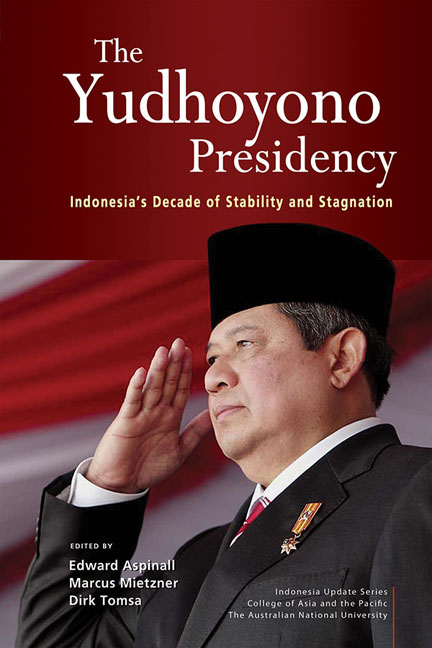Book contents
- Frontmatter
- Contents
- Tables and figures
- Contributors
- Acknowledgments
- Glossary
- 1 The moderating president: Yudhoyono's decade in power
- 2 Prologue Yudhoyono's legacy: an insider's view
- PART 1 PERSONAL, COMPARATIVE AND INTERNATIONAL PERSPECTIVES
- PART 2 INSTITUTIONS, POLITICS AND SECURITY
- PART 3 GENDER, HUMAN RIGHTS AND ENVIRONMENT
- PART 4 THE ECONOMY AND SOCIAL POLICIES
- 15 The Indonesian economy during the Yudhoyono decade
- 16 The Yudhoyono legacy on jobs, poverty and income distribution: a mixed record
- 17 Ambitious but inadequate: social welfare policies under Yudhoyono
- Index
- Miscellaneous Endmatter
15 - The Indonesian economy during the Yudhoyono decade
from PART 4 THE ECONOMY AND SOCIAL POLICIES
Published online by Cambridge University Press: 19 May 2017
- Frontmatter
- Contents
- Tables and figures
- Contributors
- Acknowledgments
- Glossary
- 1 The moderating president: Yudhoyono's decade in power
- 2 Prologue Yudhoyono's legacy: an insider's view
- PART 1 PERSONAL, COMPARATIVE AND INTERNATIONAL PERSPECTIVES
- PART 2 INSTITUTIONS, POLITICS AND SECURITY
- PART 3 GENDER, HUMAN RIGHTS AND ENVIRONMENT
- PART 4 THE ECONOMY AND SOCIAL POLICIES
- 15 The Indonesian economy during the Yudhoyono decade
- 16 The Yudhoyono legacy on jobs, poverty and income distribution: a mixed record
- 17 Ambitious but inadequate: social welfare policies under Yudhoyono
- Index
- Miscellaneous Endmatter
Summary
After a decade in power, President Susilo Bambang Yudhoyono left Indonesia a more prosperous country than any of his five predecessors. He pledged to be a president who would be ‘pro-growth, pro-jobs, pro-poor and pro-green’. That is, he staked his leadership credentials on rapid socio-economic development. At one level, one could argue that he achieved this goal, as the Indonesian economy enjoyed moderately strong growth during his tenure. If one digs deeper, however, it becomes clear that there are contrasting narratives on his economic record. According to one viewpoint, he inherited a fragile economy and political system, and he consolidated both, to the point where Indonesia is now the world's tenth-largest economy (as measured by purchasing power parity) and a robust democracy. An alternative narrative recognises these achievements but also laments Yudhoyono's timidity on key economic reform issues, notably fuel subsidies, the infrastructure deficit, economic nationalism and inequality. These narratives need to be assessed in the light of a range of contextual factors that take into consideration the weight of public expectations in Indonesia, the regional and global economic environments and comparative assessments of the economies of neighbouring states or of the BRIC states (Brazil, Russia, India and China).
In this chapter I examine the performance of the Indonesian economy during Yudhoyono's decade in power (2004–14), asking four main questions. First, how did the economy perform according to conventional economic yardsticks? Second, how does this record compare with earlier periods of Indonesian economic development, and with those of comparable countries? Third, how have contextual factors affected Indonesia's economic track record? Fourth, to what extent can one draw a direct causal connection between the economic outcomes and the Yudhoyono presidency, in the sense that the outcomes were a result of initiatives and decisions of the president himself?
Drawing tight causal connections between an administration and a country's economic outcomes is a hazardous exercise given that many factors are not directly amenable to presidential control. This is obviously so in the case of global economic conditions, but domestically too there are many ‘veto players’ who can frustrate economic policy-making and reform. With this caveat, two broad themes inform this analysis. First, President Yudhoyono presided over a decade of moderately strong economic growth.
- Type
- Chapter
- Information
- The Yudhoyono PresidencyIndonesia's Decade of Stability and Stagnation, pp. 281 - 302Publisher: ISEAS–Yusof Ishak InstitutePrint publication year: 2015



